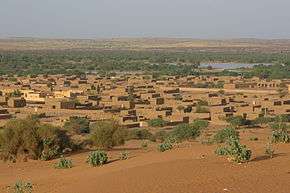Ménaka
| Ménaka | |
|---|---|
| Commune and town | |
 | |
 Ménaka | |
| Coordinates: 15°55′00″N 2°24′00″E / 15.91667°N 2.40000°ECoordinates: 15°55′00″N 2°24′00″E / 15.91667°N 2.40000°E | |
| Country |
|
| Region | Gao Region |
| Cercle | Ménaka |
| Area[1] | |
| • Total | 14,900 km2 (5,800 sq mi) |
| Population (2009 Census)[2] | |
| • Total | 20,702 |
| • Density | 1.4/km2 (3.6/sq mi) |
Ménaka is a rural commune and town in Ménaka Cercle, Gao Region, in eastern Mali. It is the local government seat and largest town in the Cercle, and one of four rural communes. Ménaka is in the midst of the Saharan desert, along wadi Ezgeuret, and ancient dry river valley of the Iullemmeden Basin.
Ménaka Cercle is a rural, isolated, and largely desert area, crisscrossed by seasonal wadis, part of the Azawagh region. The area includes the rocky outcrops of the Ader Douchi hills, in the midst of which Ménaka town sits. Its highest point, Mount Abourak, lies across dunes around 150 km to the north.
Most of the small population are nomadic Tuareg tribal populations, as well as nomadic minorities, including the Wodaabe Fula and sedentary Songhai people. The area is a traditional center of the Kel Dinnik Tuareg confederation — as well as the smaller Iwellemeden Kel Kummer, with the town of Andéramboukane, near the Nigerien border, being one historic center for their transhumance communities.[3] Andéramboukane is 100 km south on the main road, which runs through Ménaka, west 210 km to Ansongo on the Niger River, and a further 95 km north to the regional capital of Gao. The town is served by Ménaka Airport.
Tuareg rebellions
The Ménaka area was a center of Ag El Insar Firhoun's Malian rising of larger 1916 Tuareg Rebellion, and was a government garrison town in the 1961–1964, 1990–1995, and the 2007–present Tuareg Rebellions. Most recently, Ménaka was put under siege and the military post sacked by former rebels who had been integrated into the Malian Army in a short term rising in May–July 2006. The current May 23, 2006 Democratic Alliance for Change rebel group dates from this siege.[4]
On 17 January 2012, Ménaka was captured by the National Movement for the Liberation of Azawad (MNLA), a Tuareg rebel group.[5] On 19 November they lost their control to the Movement for Oneness and Jihad in West Africa and Al-Qaeda in the Islamic Maghreb.
2009 kidnappings
On 25 November 2009, a French citizen Pierre Camatte was taken hostage from a hotel in Ménaka city. A January 2010 statement issued by the AQIM, the north African branch of al-Qaeda, set an ultimatum of 20 days for the exchange of four al-Qaeda members for Pierre Camatte, after which, it said the French and Malian governments "will be fully responsible for the French hostage's life".[6] Camatte was freed 6 weeks later following a prisoner swap deal in which the four Islamists were released.[7]
Slavery
Malian and international Human Rights organisations pointed to Ménaka in 2008, as one of several towns in the Gao Region in which informal slavery relations persist between noble caste Tuareg pastoralists and thousands of sedentary low caste Bellah Tuareg.[8]
References
- ↑ "Common and Fundamental Operational Datasets Registry: Mali", United Nations Office for the Coordination of Humanitarian Affairs http://cod.humanitarianresponse.info/country-region/mali Missing or empty
|title=(help). commune_mali.zip (Originally from the Direction Nationale des Collectivités Territoriales, République du Mali) - ↑ Resultats Provisoires RGPH 2009 (Région de Gao) (PDF) (in French), République de Mali: Institut National de la Statistique.
- ↑ Imperato, Pascal James (1986). Historical Dictionary of Mali. Metuchen NJ - London: Scarecrow Press. pp. 100–200, 235. ISBN 0-8108-1369-6.
- ↑ MALI: Armed men seize three military bases in remote north. 23 May 2006 (IRIN).
- ↑ "Strife in the Sahel: A perfect desert storm". The Economist. 17 March 2012.
- ↑ Frenchman Pierre Camatte kidnapped in Mali. 11 January 2010. BBC News.
- ↑ http://news.bbc.co.uk/1/hi/world/africa/8537262.stm Freed French hostage speaks of al-Qaeda ordeal in Mali] - BBC News, 25 Feb 2010
- ↑ Mali: Thousands Still Live in Slavery in North. IRIN (United Nations). 14 July 2008.
External links
- Plan de Sécurite Alimentaire Commune de Ménaka 2005-2009 (PDF) (in French), Commissariat à la Sécurité Alimentaire, République du Mali, USAID-Mali, 2005.
